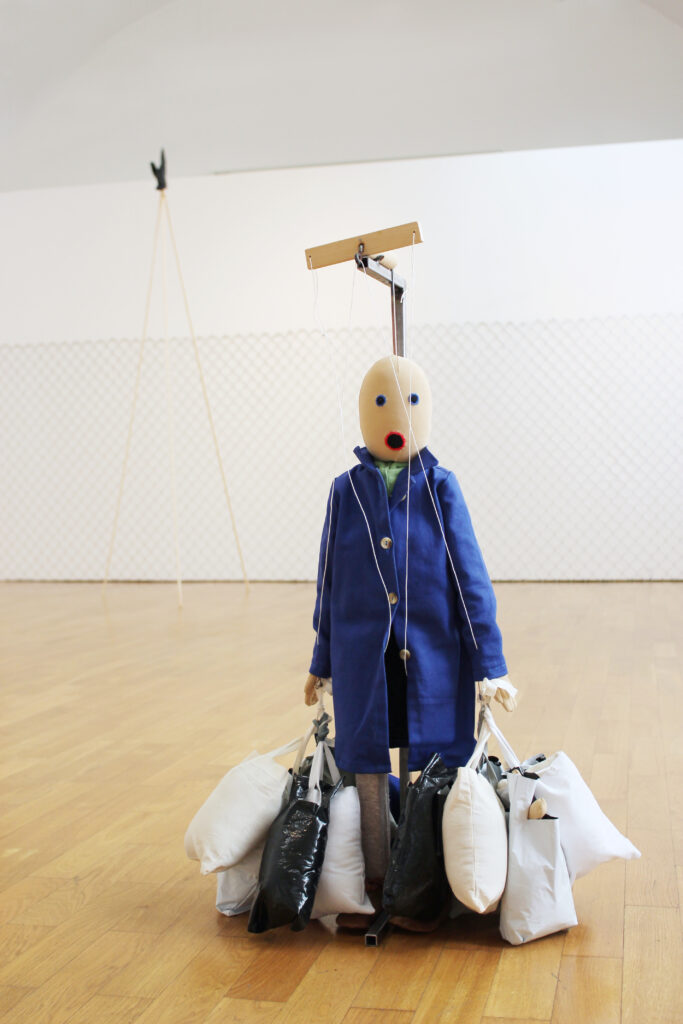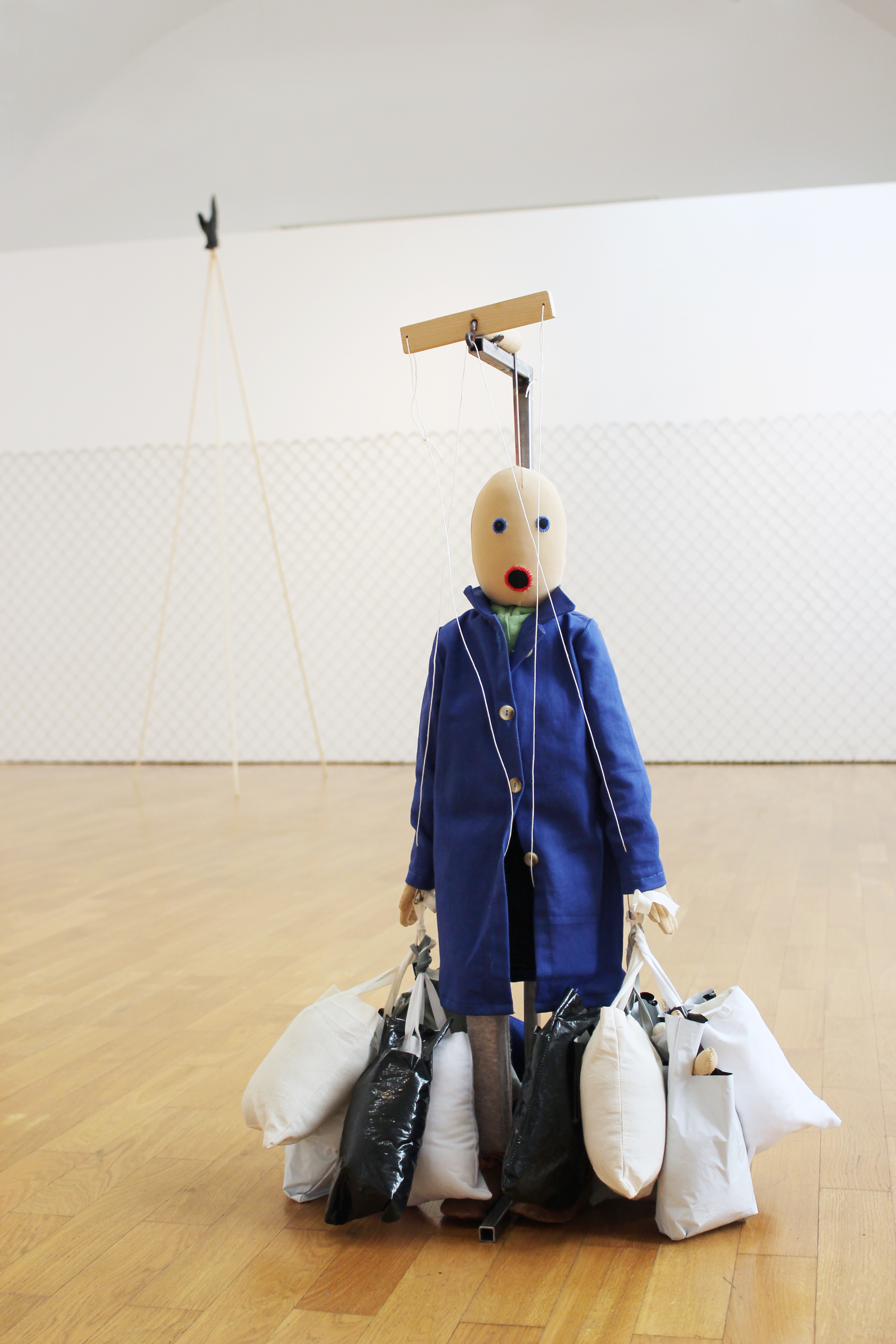
Artist: Eva Kot’átková, Jiří Kovanda, Karolína Liberová
Title: Lenka
Curator: Anezka Jabůrková
Venue: Tschechisches Zentrum, Wien
Photos: Jan Stehule
Car seats, chairs, shoes, jackets, and gloves—objects around us designed to serve us best. Clothes keep us warm, ergonomically designed car seats allow us to travel for long hours, shoes make running easier, gloves protect us from injuries, and chairs enable us to sit comfortably. From early childhood, we feel that we are surrounded by objects tailored to meet our needs. As we grow, we come to understand that society is a complex web of relationships, where not only seemingly inanimate objects are adapted to optimize its functioning, but we ourselves are also cultivated for this purpose. The group exhibition Lenka, featuring artists Eva Kot’átková, Jiří Kovanda, and Karolína Liberová, attempts to arouse our interest, curiosity, and sensitivity toward the often overlooked or neglected stories of things, people, and animals. Offering us the tools to unravel this complex net.








The exhibition unfolds around the story of Lenka, the giraffe whose body now rests in the National Museum in Prague. She was brought to Prague Zoo from Africa in the 1950s as the first of its kind. Only two years after she was housed there, she died. The long journey, the separation of the young animal from its mother, and, above all, the inadequate food provision due to Central European climatic conditions contributed to its premature death. Her body was eventually acquired by the National Museum in Prague, where it was taxidermized and exhibited until 2005. Rumor has it that an accident occurred during the taxidermy: an unusual odor allegedly escaped into Wenceslas Square, and part of the square had to be temporarily closed off. Her story is told by Lenka, a custodian employed by the museum to oversee its collections.

Lenka, the employee, develops a special bond with the animal and gradually begins to confide in it. The exhibition is not a simple reconstruction of these stories. It serves as a stimulus to reflect on what the treatment of our surroundings tells us about our society and the world in which we live. Visitors are encouraged to reflect on the hierarchies that have allowed the giraffe’s story to unfold as it has. What role do museums and zoos play? More precisely, the cultural institutions that organize exhibitions and fulfill an educational and recreational function in society. Which stories are told, and which are omitted, covered up, or even suppressed? What role does the exhibited object itself assume? The artists: Eva Kot’átková, Jiří Kovanda, and Karolína Liberová transform the gallery space into an imaginative landscape.























In their works, they explore the variously uneven relationships between objects, bodies, and their surroundings. Concurrently showing leaks that weaken the current structure.
Characteristic of the work of Eva Kot’átková is the collecting of stories and tales. The installations enable the audience a glimpse into her archive. In doing so, she offers visitors the opportunity to perceive other layers of realities and to reflect on the mechanisms and processes behind the formation of the perception of ourselves and our surroundings. She creates landscapes in which we encounter normative patterns and narratives of oppression, as well as imaginative scenarios, of how we can alter them. The group exhibition at the Czech Center Vienna, which Eva Kot’átková jointly prepared with Jiří Kovanda and Karolína Liberová, is no exception.
However, not only the viewers are invited to associate and reflect but also the participating artists. Behind the idea of Jiří Kovanda’s and Karolína Liberová’s reactive work to the story traced by Eva Kot’átková is not only their close professional relationship but also an interest in observing the engagement with the subject matter by artists of different generations and experiences.
Jiří Kovanda is best known for his artistic actions from the 1970s in totalitarian Czechoslovakia, which he documented thoroughly himself. The photographic record of the actions is glued on white paper, above which there is a cut-out inscription typed on a typewriter with the name, date, and place. These minimalist actions and interventions were so subtle that they were hardly noticed by passers-by. From today’s perspective, the works are interpreted in the context of the procedures employed by the secret police. The people under surveillance were indistinguishable from other people at the time, and it is only through the surveillance archive that we learn that these people, who seem to be doing ordinary things, are in fact considered enemies of the state by the secret police. His current works are equally subtle and minimalist, but also subversive. With inconspicuous gestures in space and time, he draws attention to a complex system of relationships that binds the object to its surroundings.
Karolína Liberová recently graduated from the Academy of Art, Architecture and Design Prague in the fashion design studio. She honed her artistic skills in the Czech Republic, Austria, and Sweden. In her work, she deals with the question of how to think about the physicality of objects. More specifically, how our understanding of objects changes when we no longer perceive them as inanimate entities subordinate to humans. She is primarily interested in the memory and experience of these objects. In this way, she creates a new cosmos of relationships and relations.
The group exhibition Lenka discusses the story of the giraffe and the employee of the museum and their relations to the environment surrounding them. But how many other stories are found in our surroundings, without us even noticing them?
